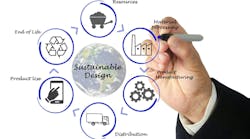Industry leaders bullish on sustainability...and looking for guidance
By Chris McNamara, Smart Industry editor in chief
Early this year, Honeywell released its 1Q 2023 Environmental Sustainability Index, a quarterly indicator of key trends pertaining to global efforts in climate-change mitigation and other sustainability initiatives that provides a comparison of corporate sentiment and progress against environmental-sustainability initiatives across sectors on a global basis.
The global study, which surveyed more than 750 business leaders involved in the sustainability process, revealed that nearly 98% of organizations have been at least somewhat or extremely successful in achieving at least one or more sustainability goals over the past 12 months. When it comes to meeting their goals by 2030, an anchor deadline year for numerous commitments, there is an increased level of optimism quarter over quarter across all sustainability categories including energy efficiency and evolution, emissions reduction, pollution prevention, and circularity/recycling.
“Despite challenging macroeconomic conditions, organizations remain committed to the fight against climate change and their sustainability goals,” said Darius Adamczyk, chairman and CEO of Honeywell. “While data shows an increased sense of optimism towards reaching goals, we know decision makers are still very perplexed on what their respective journeys and roadmaps look like towards their targets. With over 60% of our annual revenue stemming from solutions that contribute to ESG-oriented outcomes, and approximately 60% of our R&D spend being directed toward ESG-oriented innovation, we have deep experience and expertise to help organizations around the world reach their sustainability targets even in a tougher economic environment.”
Honeywell itself committed in April 2021 to become carbon neutral in its operations and facilities by 2035 through a combination of further investment in energy savings projects, conversion to renewable-energy sources, completion of capital improvement projects at its sites and in its fleet of vehicles, and utilization of credible carbon credits where needed, they claim. These initiatives represent a continuation of the company’s sustainability efforts that began in 2004 and have already yielded a reduction in greenhouse-gas intensity of more than 90%. Honeywell has also committed to setting a science-based target, including scope 3 emissions, with the Science Based Targets initiative (SBTi).
We wanted to learn more, so at the recent ARC Forum event in Orlando, Florida we connected with Honeywell’s Ravikrishnan Srinivasan, VP GM, emissions-reduction leader for industrials, who focuses on “leading customers to net zero,” and Mohammad Hoda, Honeywell’s director of carbon neutrality. The pair were at the ARC event to present on sustainability trends, levels of commitment from industrial CEOs, and pressure to adopt these approaches from investors and customers.
They noted how companies with better ESG scores have greater access to funding, how products produced with lower carbon footprints are sought out by consumers, and how even oil producers are now touting lower emissions in their sales pitches.
“If you want to mitigate emissions, you have to measure them in real time,” explained Srinivasan, touching on new Honeywell solutions that afford operators such real-time visibility, monitoring, for example, rising methane, using artificial intelligence to triangular where the leak is coming from, quantifying the severity of the leak, and guiding teams to resolve the problem. This top-down measurement, reliant on hyperspectral imaging, is being deployed at myriad process facilities, primarily in the oil-and-gas sector.
The duo stressed how creating accurate baselines for emissions enablers more accurate AI models that result in quicker discovery of outlying behaviors—advanced process-control optimization that “makes processes less sloppy,” according to Hoda. Such processes consume less energy, and enabler optimal performance from assets from compressors to boilers. These baselines also inform digital-twin models linking emissions to larger potential problems such as asset failure.
The pair touched on new technologies they detailed in their presentation—emerging carbon-capture techniques and blue hydrogen programs. Initiatives to convert feedstock into aviation fuel.
“The differentiation is that we at Honeywell have the sensors, the software, the digital transformation backbone, the prediction strategies and licenses to guide customers through this journey end to end,” said Srinivasan. “Because we know that our customers are not cutting back on these projects.”
“Every large company has this goal, they are trying to figure this out,” added Hoda. “And we are moving quickly now. These projects are part of the whole business strategy.”



